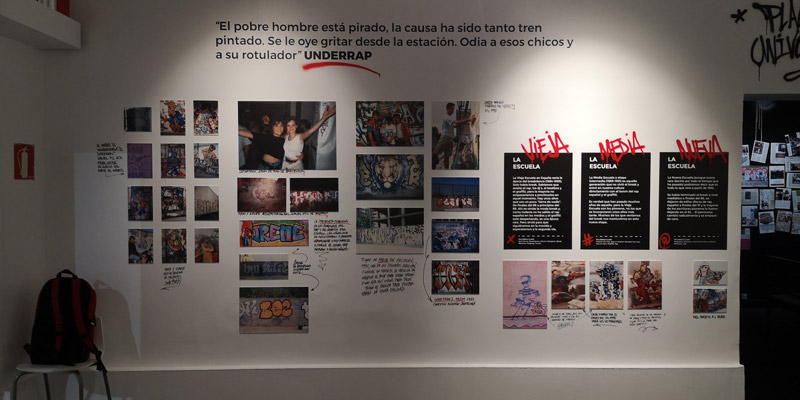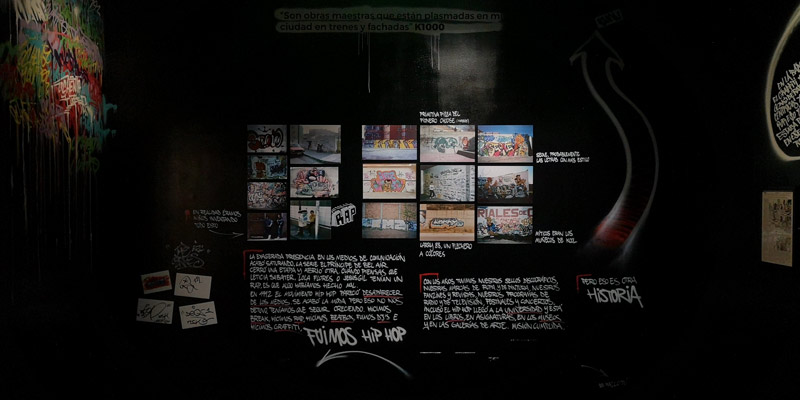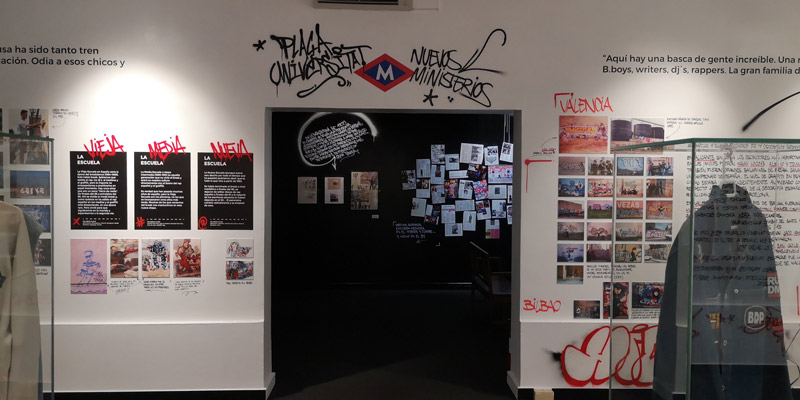- About MTN
Would you like to stay up to date on the latest MTN world news? Products, graffiti, murals, festivals, art and much more.
Return It all started in the eighty-four
On June 24, the first ever exhibition dedicated to the history of the beginnings of Hip Hop in Spain was inaugurated in a museum. The National Museum of Anthropology in Madrid hosts the exhibition under the name “Todo empezó en el ochenta y cuatro” (It all started in eighty-four). Perhaps the recognition of this culture by institutions is an honorable coming-of-age for hip-hop. We contacted the curator and the director of the Museum to tell us about it, and what the experience has been like.
The eternal debate on whether graffiti can / should be exhibited in galleries or if only belongs on the street has entered a new playing field. Less than two weeks ago, the exhibition “Todo empezó en el ochenta y cuatro” (It all started in eighty-four)" was inaugurated at the National Museum of Anthropology. A retrospective on how hip-hop — and therefore graffiti — arrived in Spain.
Curated by Pastrón7, the exhibition features jewels treasured for decades by the pioneers of Breakdancing, who with hardly any awareness planted the flag of a culture that has grown exponentially and has become independent of its origins.

The National Museum of Anthropology, which was inaugurated in 1875, collects and studies the human being in an integral way, its physical characteristics and its culture. Perhaps that is why it is so important that the exhibition takes place in a museum like this one, because it implies a public recognition by the institutions that did not exist until now. While it is true that for many graffiti writers this won’t change anything at all,, for many others it means a legitimization of their career and their aspirations.
A WALK THROUGH HISTORY
In the conversation we had with Pastrón7, he told us that, "the show is about telling the story of those who lived hip-hop in Spain from ‘day one,’ so that people outside our culture know it, so that the new generations of hip hop know the past, and so they can better understand the present and to touch the heartstrings of those who lived it and can take a trip back in time."
THE GATEWAY: THE 80s AND BREAKDANCING
The exhibition, which was essentially constructed from the personal archives of Pastrón 7 and the artistic direction of Alberto Mingote — who has also did the art direction for a graffiti book about New York that Pastrón has just published — has four rooms: in the first one, we travel to the breakdance era and its arrival in our country in 1984 and 1985, where the new dance became known thanks to a very conducive environment — the flashy look of the 80s — and the famous films on the subject.

MUELLE, ‘LOS FLECHEROS’ AND RAP
In the next room, we find an area dedicated to ‘los flecheros’ and the first graffiti writer in Spain, Muelle — who you can see in the video that we recently released here.
The third room, the largest, is dedicated to the boom of rap and graffiti in our country (1989-1991). In it, we can find a space dedicated to the first rap albums (Madrid Hip Hop, Navidad Hip Hop, Rap'in Madrid and Rap de Aquí) and to the most outstanding artists of those years.
THE ARRIVAL OF GRAFFITI
"The rest of the room is dedicated up by graffiti. The crown jewels are the original signature cut-outs of subway advertising posters, collected over the years by Larry 88 and exhibited for the first time in a museum. The showcases are full of objects, clothes, sprays, markers, sketches..." It’s nothing more and nothing less than a nostalgic journey through time.
More than 700 photos of mythical pieces by relevant and not-so-relevant people occupy most of the space, a good sampling that helps to represent the spirit of the time. People like Chile, Felipe Gálvez, Fini and Shrimpy (Freeze Rockers), Glub, Kapi, Koa, Larry88, Maese KDS, Randy, Skeep, Stimie, Suso33, Mata, Toeo, Zeta...the list is endless.

MEDIA
The last room is dedicated to the media and the effect that the scenehad on the press from the beginning. In each room there is a monitor with looped images from the era, provided by TVE. From the performance of Break Machine in the 1, 2, 3, to the Tocata contest, through the performances of Jungle Kings, Sweet or Randy in Rockopop.
Finally, we leave you with the words of the director of the Museum.
"For the National Museum of Anthropology, it was not difficult to take on the challenge of organizing the first exhibition on the origins of graffiti and hip-hop culture in Spain. An institution like this, whose current mission is to defend the values of multiculturalism and diversity, could not miss the opportunity to show, with its protagonists in first person, a cultural reality very present in our current urban environments. We were interested above all, as a cultural institution and from the approach, to trace and fix its origins, which, as is well known, date back to the 80s. As Francisco Reyes (curator of the exhibition) tells us, "It all started in 1984.”
This urban cultural movement, imported from North American cities, managed to connect with a generation of young Spaniards who in breakdance, rap, and graffiti found a particular form of expression. Those young men and women are the pioneers of contemporary street art.
“Todo empezó en el ochenta y cuatro” is the first temporary exhibition that forms part of a program that the National Museum of Anthropology is going to dedicate to urban cultures, and that will have continuity in the coming years. That is why it is special for our team. For that reason, and for the magnificent work of Francisco Reyes and Alberto Mingote, with the help of a good number of comrades — Kapi, Suso, Zeta, Mata, Larry, Randy, Chile, Remebe, Toro — and the collaboration of the people and entities that have lent us objects, images, resources and time to make it possible, to whom we cannot be more grateful".
You can visit the exhibition until November 1st of this year.
ShareAugust 26, 2022
